Consolidation and practice
These resources are to support children in guided or independent work. Roll over the highlighted resources for a description.
Decimal number line
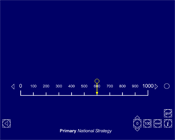
This interactive teaching program (ITP) is an ICT-based tool to support the exploration of place value within whole and decimal numbers. Decimal number line ITP allows the child or teacher to select an interval from a given number line and show that interval divided into ten equal parts but on a bigger scale, which can then be repeated.
Measuring scales
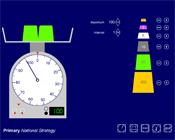
This interactive teaching program (ITP) is an ICT-based tool to support the exploration of number, measures and problem solving. Measuring scales ITP allows the child or teacher to add different masses of 1, 2, 5, 10, 50, 100 and 500 units to a scale pan. The scale intervals can be changed to challenge children to interpret different scales.
Measuring cylinder
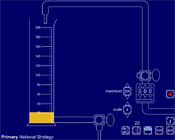
This interactive teaching program (ITP) is an ICT-based tool to support the exploration of number, measures and problem solving. Measuring cylinder ITP allows the child or teacher to simulate varying intervals on a scale, pouring liquid into the cylinder and interpreting the scale. The ITP can be used to explore and consolidate the interpretation and reading of scales, mental calculation strategies and methods of recording.
Number line
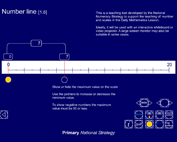
This interactive teaching program (ITP) is an ICT-based tool to support the exploration of number. Number line ITP allows the child or teacher to display a range of numbers from minus 50 up to 500. Children can estimate a number on the number line, explore the concept of difference between two given numbers and demonstrate their calculation strategies.
Opportunities to use and apply
Possible contexts include:
- approximation in calculation, e.g. 378 − 83, what is the approximate answer?
- addition and subtraction involving rounding and adjusting, e.g. Children find 52 + 29 by calculating 52 + 30 then subtracting 1.
- money and measures, e.g. What is 275p rounded to the nearest pound? What is 845 cm rounded to the nearest metre?
- reading scales to the nearest numbered interval, e.g. What is the weight shown on these scales (to the nearest
100 g)?
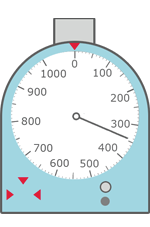
Confirming learning
Ask probing questions such as:
- What tips would you give to someone who is learning how to round numbers to the nearest 10 or 100?
- The local newspaper said that 800 people attended a concert. This was given to the nearest 100. What is the smallest possible number of people who attended? What is the largest possible number?
- Round 348 and 352 to the nearest 100. Why do they round to different numbers?
- A number is rounded to the nearest 10. The answer is 720. How many different possible start numbers are there? What are they?
- Round 296 to the nearest 10. Round it to the nearest 100. What do you notice? Can you suggest another number like this?
 Counting and understanding number
Counting and understanding number




